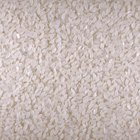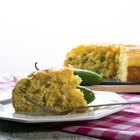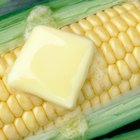
Whether you're frying seafood, chicken, meat or vegetables, a good batter that adheres to the food will create a crispy outer crust during frying. There are many individual recipes for batter, but all of those that use both baking soda and flour rely on the same principles for creating the lightness you expect from a good fried crust. Understanding the purpose, chemistry and preparation behind the ingredients will allow you to create the batter that best suits your taste. You will no longer be limited to just all-purpose flour, either, with additional options such as chickpea flour.
The Importance of Flour
In a batter, the amount and type of flour most influences the quality of the batter. Adding too much flour may result in a tough batter, too little may make the final coating too fragile after frying. The protein in flour helps the batter cling both to the object fried and to itself, for a cohesive covering. The protein also forms the elastic strands of gluten and absorbs fat and moisture. Too much absorption will result in an oily and chewy coating. All-purpose flour, which is a wheat flour with a moderate amount of protein, offers a solid base for a batter when it's well balanced in a recipe.
All-Purpose Alternatives
Several other types of flour work as well as all-purpose flour for making batters. Rice flour batters provide crispier and drier results than their wheat-based counterparts because rice proteins absorb less fat and moisture and do not form gluten. Corn flour offers similar benefits. To reduce the influence of wheat proteins in a batter with all-purpose flour, you can add pure cornstarch to the mix. Chickpea flour creates a nutty and crisp coating for fried foods and has the added benefit of being wheat-free for those with an intolerance. Avoid using root flours, as their starch content will become gelatinous and begin to disintegrate during the beginning of the frying process.
The Importance of Baking Soda
Baking soda serves as a leavening agent in a flour-based batter. The reaction of the baking soda with the liquid in the recipe creates gas bubbles. This release of carbon dioxide gas is responsible for adding the lightness to the final fried product. Adding a small amount of acid, such as lemon juice or buttermilk, to your batter will heighten the reaction. While it may be tempting to replace baking soda with baking powder, do not do so. Baking powder is a combination of baking soda and cream of tartar and is about one-third to one-quarter as strong as the soda.
Particular Preparation
Whatever recipe for batter you choose to follow, keep in mind several important factors about the preparation. Most batters adhere best to moist foods if the food is first dredged in a dry ingredient. The dry particles stick to the moist food, creating a rough surface for the moist batter to cling to when the food is dipped. Roll the food you intend to fry in seasoned flour, shake it off, and then dip it into the batter. Prepare your batter as close to the moment you start frying as possible, to prevent the gas bubbles caused by the baking soda from leaking out. If much of the air and gas escapes the batter, you will end up with a dense covering on your fried food. Additionally, use cold water for the batter and mix it as little as possible to combine it, to prevent gluten development and too much water absorption.
Related Articles

How to Bake With Rice & Potato Flours

Can I Make Boxed Devil's Food Cake Mix ...

Baking Muffins With White Rice Flour

What Kind of Flour to Use for Cupcakes?

Can You Substitute Vegetable Shortening ...

What Kind of Oil Do You Use in Brownie ...

How to Cook With Coconut Flour for Main ...

Can You Use Konjac Flour in Baking?

How to Make Bread Chewy

Can I Substitute Bleached for ...

How to Replace Flour With Oat Flour

Can I Coat Chicken Wings in Cornstarch ...

How to Bake a Cake Without Egg Whites

Corn Starch Vs. Rice Flour As ...

Can I Deep-Fry the Food the Night ...

The Purpose of Buttermilk in Baking
Baking With Almond, Rice & Coconut Flour

Common Food Emulsifiers

How to Add Gluten to All-Purpose Flour

Can You Use Bread Flour Instead of ...
References
- On Food and Cooking: The Science and Lore of the Kitchen; Harold McGee
- The Professional Chef; The Culinary Institute of America
Resources
Writer Bio
Kathryn Roberts has worked in the culinary industry for nearly a decade in various roles, including pastry chef and bakery manager. After studying at the Culinary Institute of America, she earned her BFA from Goddard College and is pursing an MFA in Writing from Vermont College of Fine Arts.
Photo Credits
Ryan McVay/Photodisc/Getty Images